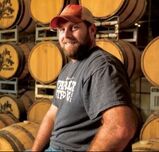|
Featuring Guest Speakers

Rick Clark is a Williamsport, Indiana farmer. He is a 5th generation farmer. To quote the National No-Till Farmer, “To Rick Clark, ‘Farming Green’ is a systematic approach to regenerative soil health and that’s what he brings to the 7,000 acres he manages at both Clark Land & Cattle and for his family. He strives to be the best steward of the land. A main component of his no-till system is maximizing cover crop performance and planting his cash crops into living covers to build biomass, suppress weeds, recycle nutrients and feed soil microbes.” Rick has been farming for 35 years and has included no-till and cover crops in his system for the last 10 years. He is a Purdue University graduate with an Ag Economics degree. Check out this article about how Rick is cutting cost while improving soil health and stabilizing yields CLICK HERE!

Russell Hedrick is a first-generation farmer who has a dedication to growing some of the finest grain and livestock in his region of the southeast. His exceptional use of new technologies and cover crops led him to being awarded the 2014 North Carolina Innovative Young Farmer of the Year. Russell has been a featured producer in the Farm Press magazine for maximizing his cover crop benefits by mixing species and national No-till Farmer for integration of cattle onto covers and the Haney test for reducing fertilizer inputs on cash crops. He says his operation has grown through hard work to almost 1000 acres. In 2014 Russell integrated cattle into the operation and is growing warm and cool season cover crops for them to graze to utilize every acre and increase the profits for his farm. His operation focuses on maximizing profits and direct consumer marketing for all their products.
No-till planting? Cover Crops?
What is the big deal? Why do we hear about it everywhere we turn? Magazines are filled with information on this movement. Why? Because we are discovering the huge differences that exist between tilled, barren soil and soil that has been pampered and supplied with all the things it needs to become its own living, breathing organism. This organism has many benefits to us, the producer. Go ask your no-till neighbor. Many Bradford County farmers have converted to these practices in recent years. Go ask them the hard questions. See what they are getting out of it. There must be something to it or there wouldn’t be more and more of them every day. The benefits that we continue to hear about, here at the district are these. First off, good soil health can supply very large amounts of nitrogen. Nitrogen that you will no longer have to buy. It can also make the phosphorous and potassium more available to our crops. Again, less inputs to buy. Water infiltration is greatly increased. We can raise infiltration from 1-2”/hour to more than 8”/hour. This has huge consequences on our crops in a drought year. Imagine how much better they do with that much more water stored in the ground, ready for plant uptake. It also substantially reduces flooding and erosion. With all this water infiltration, you would think that the ground is going to be a lot muddier, right? Wrong. Because it has structure, it will actually be much firmer. Go ask the local custom harvester or manure spreader what ground he can get on first. It will be the no-till ground. Good healthy soil, teaming with life, will produce better yields on less inputs. That means higher profitability to you, the producer. Don’t believe the increased yields? Look up the Penn State Corn Club yields for the last 5 years. The winner, no-till. They have done it almost every year, and by about 20 bushels/acre too. Other benefits that directly affect the producer are ½ the machinery cost, ½ the fuel cost and ½ the time investment into planting the crops. That goes right to the bottom line. Like picking rocks? Me neither. This type of program will help you actually build soil and not lose it. The rocks will be where they should be, covered with good, fertile soil. No more picking rocks. Weed control can actually be improved. With a good cover crop that is terminated around planting time, the mulch it produces with help smother any of the normal weeds that we fight with. By the time the mulch is gone, the canopy exists and then shade controls the weeds. Cover crops harbor beneficial insects that prey on the insects that we battle all the time. If we have beneficial ones, then they will do the work for us and we will have less insect problems. Soils are cooler in the summer and warmer in the winter. Both are good things. Maybe the question we should be asking ourselves is not “why should I move toward cover crop and no-till program” and ask ourselves “why are we still tilling and why do we leave our soil bare ½ the year”? Let’s let the soil (and sun) work for us. I am sure there are many other things we can find to do. |
|
Bradford County Conservation District
Stoll Natural Resource Center 200 Lake Road, Suite E | Towanda PA 18848 Phone: (570)-485-3144 |

